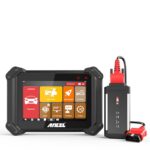Are you a car enthusiast or a DIY mechanic looking to understand your vehicle better? In today’s tech-driven world, accessing your car’s onboard diagnostics system is easier than ever, especially with your iPhone. While basic scan tools can read trouble codes, they often leave you guessing at the root cause. This is where the power of real-time data monitoring through iPhone OBD2 Bluetooth connections shines, offering a superior diagnostic experience – and you likely won’t even need a jailbreak to achieve it.
Many entry-level scan tools, much like the one I started with, cap out at simply retrieving diagnostic trouble codes (DTCs) and capturing freeze frame data. Freeze frame data provides a snapshot of a few parameters at the moment a code is triggered. My initial setup included software to download this limited data to a computer, offering code definitions and potential causes. This is helpful, but it’s akin to getting a weather report from yesterday – useful for broad strokes, but not for understanding the dynamic weather system right now.
After discussing a perplexing issue on my older vehicle with a fellow car enthusiast, the true advantage of real-time data became clear. Imagine being able to watch your car’s sensors in action as it runs. Instead of a static picture, you get a live movie of what’s happening under the hood. This real-time visibility into sensor inputs is a game-changer for accurate and efficient diagnostics.
Consider the common OBD2 code P0171, indicating “Bank 1 Lean,” which my dad encountered on his 2004 Tacoma. This code has a laundry list of potential culprits, ranging from a dirty Mass Air Flow (MAF) sensor and a sticking throttle body to faulty injectors or O2 sensors. My basic scan tool only told me the fuel trim values at the time the code set. While the accompanying software indicated these values were outside the acceptable range (+/- 15%), explaining why the code appeared, it didn’t pinpoint the cause. Without real-time monitoring, diagnosing the issue becomes a process of elimination, often involving guesswork. Being able to observe live data from the MAF and O2 sensors would immediately reveal if they were sending inaccurate readings. Similarly, monitoring the Throttle Position Sensor (TPS) in real time could expose a sticky throttle body.
Instead of real-time data, I resorted to educated guesswork. Knowing my dad lives on a dusty dirt road, a dirty MAF sensor seemed like a strong possibility. Sure enough, the MAF was heavily contaminated. While cleaning it, I also noticed significant carbon buildup in the throttle body, prompting a thorough cleaning of that component as well. This fixed the issue, but it was a somewhat roundabout approach.
This experience solidified the value of advanced OBD2 tools capable of real-time data streaming. The ability to monitor live parameters provides a significantly deeper level of diagnostic insight, ultimately saving time and effort in pinpointing and resolving car problems. For iPhone users, the good news is that numerous Bluetooth OBD2 adapters and compatible apps are readily available, often without requiring a jailbreak of your device for standard functionality. While jailbreaking might offer access to some specialized apps or system-level tweaks in niche cases, for the vast majority of car owners seeking enhanced diagnostics, a standard Bluetooth OBD2 adapter and a user-friendly iPhone app will unlock a wealth of real-time data, empowering you to understand your car’s health like never before and move beyond simple code reading for truly effective car repair.
